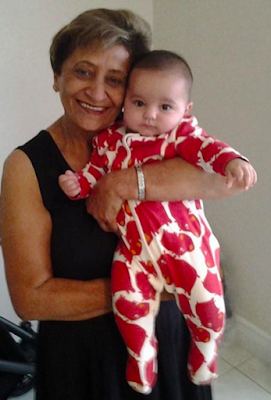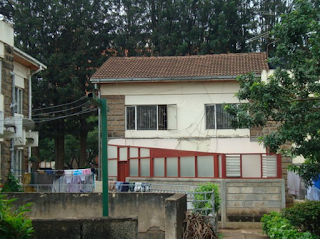Aga Khan schools are run by the Aga Khan Development Network in developing countries.
http://www.agakhanschools.org/about_africa.asp
It was a public school and in Kenya, students in public schools wear uniforms. The girls uniform was a white short sleeved shirt with a front pocket, a green tunic, a red and green striped tie and a belt with white socks and black shoes that had to be polished every single day! Boys wore a white shirt, the same tie and khakhi pants.
 |
| Farah, Minaz & Faiza in our Aga Khan Primary school uniform with Mum |
Our school year started in January and ended in December. We had three terms and our holidays were the months of April (Easter), August and December (Christmas).
Standard 2 (1974)
Apparently I should have gone into Standard 3, but for some reason I didn't. My sisters were in Standard 1 when I was in Standard 2. I was in Standard 2M, in a class that overlooked the canteen and the bursar's office. I felt like a fish out of water on my first day of school; I was new, didn't know anyone and had joined mid way through. What gave me comfort though was being in my favourite blue and pink dress with white collars and a bow. I remember answering a question on this first day and feeling so special, but don't remember what that question or the answer was. I remember nothing else about Standard 2.Standard 3 (1975) - Mr. Irungu
Mr. Irungu, my teacher in Standard 3M was probably my favourite teacher at Primary School. Whenever I look back on teachers, he's the one that always comes up. He'd challenge us with vocabulary and give us prizes for the right answer. I got a prize for knowing the meaning of "bobby" - policeman! I also remember the female teacher for the deaf students would come and hang out in our class for what seemed ages - I think they had a thing going! Mr. Irungu once brought a pile of letters into class and we had to go up and pick one. A girl called Eva-Lotta Ytter, become my Swedish Penpal. Eva-Lotta and I are still Facebook penpals! |
| Eva-Lotta (now Melin), my Swedish Penpal from 1975, and now my Facebook Friend! |
Standard 4 (1976)
My Standard 4M class was at the end of the hall. I don't remember much except there was this guy that was crazy about this girl, Mayuri. I also remember that it was the year that my friend, Khatija's mum passed away. I remember someone from the office coming to call her. I can't imagine how difficult that must have been.Standard 5 (1977) - Miss Mohamed
Miss Mohamed was the Standard 5M teacher. The class was right next to the canteen. Miss Mohamed was short with long hair, had a smile with dimples. She was a good teacher. She wore trouser suits every day. Mid way through school, we had a new kid in class, Shaheen Sidi. We were in awe of her because, she came from Canada and had an attitude about her that was different from ours! Shaheen and I became good friends and I had many sleepovers at her house that was just behind the primary school. Miss Mohamed got us to learn the poem, The Owl and the Pussycat and each of us had to say it on stage. I can still remember parts of it because we had to practice it over and over again in slow motion! I especially remember Farez reciting it! |
| My sister's friend, Yasmin Devji has copies of the old school magazine and sent me this! I was dumbfounded! I can't even remember writing it! |
Standard 6 (1978) - Mrs. Sihra
In Standard 6A, we had Mrs. Sihra for our teacher. She was pregnant for the entire time I can remember. She was a khali teacher (strict!) and she didn't hesitate to pick up a ruler and hit you with it! She wore pretty colours and styles of Indian suits to school every day. I remember my first school dance. It was by the pool. This would be my first dance ever and I think we were all very nervous about who was going to ask us to dance!Standard 7 (1979) - Mr. Gachoki
In 7A, we had Mr. Gachoki for our teacher. He was also the Math teacher. Boy, was he was strict. I don't remember him hitting the girls, but he would ask the boys to lift their shorts and then hit them with his bare hand on their thigh! I can still hear that sound when the hand met the thigh! Those poor boys! At the end of Stardard 7, we did the CPE exam (Certificate of Primary Education) which got you ready for High School. We had Mr. Weddell for English. He read us the Hobbit (would read at every lesson) and Animal Farm. Isn't it funny how after all these years, the things that stay with you are the experiences and out-of-the-ordinary teachings?!We had assembly every morning and we sang the national anthem;
and ginans (the Ismaili version of hymns). We'd have announcements and then file out.
We also had a canteen. Mrs. Bhatia was the canteen lady. The favourite thing to buy from the canteen was chips (french fries)! They were wrapped in tracing paper and you either got them cold and soggy or hot and crispy. The latter were of course better, but as long as you got them, you were happy. I remember paying 40 cents for them and they probably went up to one shilling by the time I left Aga Khan Primary. A jolly good deal!
Next door to the school was a shopping centre that you went to buy buns and soda and candy! And just outside the school a man on his bicycle with a big bag on the front of his bike came to sell mangoes. He sliced off the top, divided the mango into nine pieces and then dipped it in a mix of salt and chillies!
Across the school was the Parklands mosque and behind that was the Aga Khan hospital and right across that was my grandmother's house in Hirani Flats where we went for lunch every day until my sisters and I joined the Swim team and we had to swim right through lunch time. We didn't like it much. What we did like was that as soon as we'd finished my grandmother would have sent us hot lunch with a friend or my cousin!
When you started school you were told what team you were on and that was your team for your life at the school. Colours represented what team you were on. I was in Simba - Lion (yellow), my sister Faiza was in Chui - Cheetah (blue) and Farah was in Twiga - Giraffe (green). The fourth team was Impala (red). We had sports festivals and swimming galas that were based on these teams.
At recess we played all sorts games, but the one that stands out most is the group skipping and singing and piling up bottle tops!
Places at school:
- The bursar's office (accountant) next to staff room which was next to the canteen where we went to pay our fees!
- The principal's office where you went to get caned. (The principal's were Mr. Jabal earlier on and Mr. Hussein Teja later)
- The library.
- The sick room that you could go lie down in if you were sick.
- The field where we had PE
- The Swimming Pool
- The Assembly hall with the balcony
- The netball field/court
Other Teachers:
- First Head Master - Mr. Jabal
- Later Head Master - Mr. Hussein Teja. He taught us Civics in Standard 7.
- Deputy Head Mistress - Miss Pirani
- Mr. Kamau was our P.E. teacher. If you didn't have your P.E. uniform, you'd better have a good excuse, or he was going to come after you with a stick he just broke off a tree! He called my sisters and I 'Westrands' because we lived in Westlands and he saw us there once! He also called my sister, Farah 'Barabara' (road in Swahili) and to this day we still call her that!
- Mrs. Noorani - taught us religion (I think we had 1 - 3 religion classes a week.) At the time everyone including non-Ismailies had to sit in class
- Mr. Didace - our French teacher - He was this tall man from Burundi (I hear he's now in the US)
- Mrs. Allaudin - our geography teacher
- Mrs. Damji - used a ruler and pen to check for lice in our heads during some class!
- Miss Thobani - she taught us something but I can't remember what it was.
- Mr. Walji was the swimming teacher when we started at the school. He had a reputation for throwing kids into the deep end!
- Mr. Waweru was the swimming teacher after Mr.Walji and he was great.
My Classmates:
This is what I first wrote under this section;We used to have school magazines every year. I could kick myself for not keeping them. They'd be great to flip through and reminisce over. I also remember having a report book where they'd put all your marks and tell you what ranking you were in the class!
And then Yasmin Devji read this blog post and sent me the pages for all the Standard 7 classes. I am so grateful. Here are Standards 7E, 7H and 7M;
 |
| 7E with Mr. Gachoki |
 |
| 7H with Mr. Irungu (I had him in Std 3 - one of my favourite teachers!) |
 |
| 7M with Mr. Wedell (He came from England to teach for a bit - He introduced us to The Hobbit and Animal Farm) |
Thank you for Sharing Day 10 of 50 with me!



















































